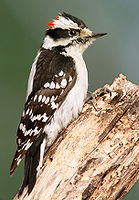 The diminutive downy woodpecker is one of the first birds to come to our feeder as fall arrives and its acrobatics and high activity make it a welcome resident of our garden and dining companion to the nuthatches and chickadees that also frequent our feeders. Although the trees on our lot are small and immature the downy wookpeckers seem to find sufficient cover and nesting sites to be content.
The diminutive downy woodpecker is one of the first birds to come to our feeder as fall arrives and its acrobatics and high activity make it a welcome resident of our garden and dining companion to the nuthatches and chickadees that also frequent our feeders. Although the trees on our lot are small and immature the downy wookpeckers seem to find sufficient cover and nesting sites to be content.
Size and Shape: The downy woodpeckers are about 5 ¾- 6 ¾” long and have a blocky head and wide shoulders.
Color: Downy woodpeckers have a white breast and belly, and broad white stripe down the head and back; their sides are black with white spots and their tail feathers are usually white with black spots. The males have a red patch on the back of the head. Their chisel like bills are relatively short compared to that of other woodpeckers.
Communication: A “pik’ sound followed by a rattle is associated with aggressive behavior; drumming is common in late summer and spring and is associated with breeding.
Range: Downy woodpeckers can be found in most of the United States but are most abundant in the eastern states; they are scarcest in the Southwest, California and southern Florida.
Habitat: The downy woodpeckers can be found in many environments from open woodlots (especially of deciduous trees) to city parks and are common in backyards.
Nesting: Monogamous pairs excavate new nest holes in spring in a dead tree stump or rotting tree, a process taking about 1-3 weeks. The hole is usually protected by overhanging branches and is at least 12 feet above the ground level. Three to six white eggs are incubated by both sexes for 12 days and both parents feed the babies for about 3 weeks.
Feeding: Downy woodpeckers are omnivores, primarily eating insects eggs, insects and other arthropods such as ants, weevils, beetles and spiders and lesser quantities of seeds and fruits such as sumac and poison ivy. They drink water that collects on horizontal surfaces including birdbaths.
Backyard Tips: Provide black oil sunflower seeds, suet, millet, peanuts, chunky peanut butter for food. Although downy woodpeckers are monogamous and share nesting and fledgling responsibilities they do not feed together so don’t be disappointed if you have only one at a time at your feeders. If possible leave a some dead logs or stumps nearby for nesting a nesting box may be used by downy woodpeckers for nighttime roosting in bad weather but they will probably not use it for actual nesting.

Well I guess Downy is a better name than Fluffy, which would be a hard name to live with
Neither downy nor fluffy describe this bird at all but consider the red bellied woodpecker; his breast looks white. I wonder if the people that named woodpeckers are on something!